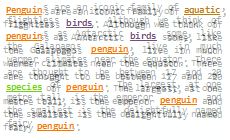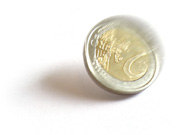“Th_ onl_ wa_ to ge_ ri_ of a tempta____ is to yie__ to it. Resi__ it, an_ you_ soul gro__ sic_ wi__ longi__ fo_ th_ thin__ it ha_ forbi____ to itse__.”
(Osc__ Wil__, The Picture __ ______ ____)
 Thanks to the verbosity of the English language, proficient English speakers generally find it relatively easy to decipher the above passage despite the numerous omissions.
Thanks to the verbosity of the English language, proficient English speakers generally find it relatively easy to decipher the above passage despite the numerous omissions.
How does one quantify this redundancy? This article introduces the notions of Shannon entropy and information rate, and experimentally estimates the information rate of written English by training a Markov model on a large corpus of English texts. This model is finally used to generate gibberish that presents all the statistical properties of written English. Best of all, the entire source code fits in 50 lines of elegant Python code.
 Most linear-time string searching algorithms are tricky to implement, and require heavy preprocessing of the pattern before running the search. This article presents the Rabin-Karp algorithm, a simple probabilistic string searching algorithm based on hashing and polynomial equality testing, along with a Python implementation. A streaming variant of the algorithm and a generalization to searching for multiple patterns in one pass over the input are also described, and performance aspects are discussed.
Most linear-time string searching algorithms are tricky to implement, and require heavy preprocessing of the pattern before running the search. This article presents the Rabin-Karp algorithm, a simple probabilistic string searching algorithm based on hashing and polynomial equality testing, along with a Python implementation. A streaming variant of the algorithm and a generalization to searching for multiple patterns in one pass over the input are also described, and performance aspects are discussed. TL;DR: I’ve taken plenty of notes while developing my
TL;DR: I’ve taken plenty of notes while developing my .png) Comparing strings is often — erroneously — said to be a costly process. In this article I derive the theoretical asymptotic cost of comparing random strings of arbitrary length, and measure it in C, C++, C# and Python.
Comparing strings is often — erroneously — said to be a costly process. In this article I derive the theoretical asymptotic cost of comparing random strings of arbitrary length, and measure it in C, C++, C# and Python. In a famous article published 1951 ((Various techniques used in connection with random digits. NIST journal, Applied Math Series, 12:36-38, 1951. This article does not seem to be available online, though it is widely cited. It is reprinted in pages 768-770 of Von Neumann’s collected works, Vol. 5, Pergamon Press 1961)), John Von Neumann presented a way of skew-correcting a stream of random digits so as to ensure that 0s and 1s appeared with equal probability. This article introduces a simple and mentally workable generalization of his technique to random dice, so a loaded die can be used to uniformly draw numbers from the set \(\{1, 2, 3, 4, 5, 6\}\), with reasonable success.
In a famous article published 1951 ((Various techniques used in connection with random digits. NIST journal, Applied Math Series, 12:36-38, 1951. This article does not seem to be available online, though it is widely cited. It is reprinted in pages 768-770 of Von Neumann’s collected works, Vol. 5, Pergamon Press 1961)), John Von Neumann presented a way of skew-correcting a stream of random digits so as to ensure that 0s and 1s appeared with equal probability. This article introduces a simple and mentally workable generalization of his technique to random dice, so a loaded die can be used to uniformly draw numbers from the set \(\{1, 2, 3, 4, 5, 6\}\), with reasonable success.